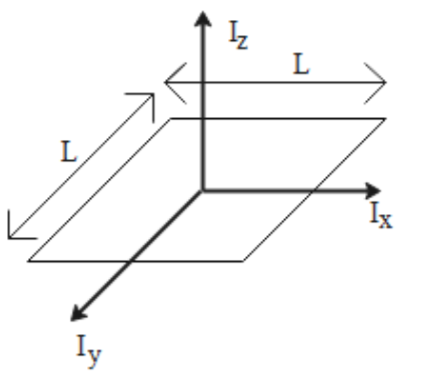Question
Question: The moment of inertia of a square lamina about the perpendicular axis through its centre of mass is ...
The moment of inertia of a square lamina about the perpendicular axis through its centre of mass is 20kg−m2. Then its moment of inertia about an axis touching its side and in the plane of lamina will be:
A). 20kg−m2
B). 30kg−m2
C). 40kg−m2
D). 25kg−m2
Solution
Hint: For solving this problem, we need to know the formula for Moment of Inertia of a square lamina whose axis is passing through the centre and perpendicular to it (its value is given), along with the theorem of parallel axis and perpendicular axis to find the answer.
Formula used: The moment of Inertia of a square lamina whose axis is passing through the centre and perpendicular to it is given by:
I=6ML2
Here L is known as the length of the square lamina and M is its mass.
The theorem of parallel axis is given as:
IAB=I+Mh2
IABis the moment of inertia of a body parallel to I and at a distance hfrom it.
Theorem of perpendicular axis is:
Iz=Ix+Iy
Complete step by step answer:
__
We are given the moment of inertia of a square lamina about the perpendicular axis through its centre of mass to be
Iz=20kg−m2
Here Iz is the Moment of Inertia of a square lamina whose axis is passing through the centre and perpendicular to it. It can be given as follows:
Iz=I=6ML2=20
From this expression, we get that
ML2=120
Now we will use the perpendicular axis theorem. Since the lamina has a shape of square, we have Ix=Iy
Iz=2Ix=20
Ix=10
Now, using the parallel axis theorem we will find the axis parallel to Ix:
IAB=Ix+M(2L)2
IAB=10+4ML2
IAB=10+4120
IAB=40kg−m2
This is the required answer. Hence the correct answer is option C.
Note: In the parallel axis theorem the moment of inertia of the axis perpendicular to the centre of mass should be known in order to find the Moment of inertia for a parallel axis which is ‘h’ distance apart or vice versa. Means of the two parallel axis one should be passing through the Centre of mass of the rotating body.
